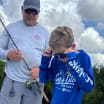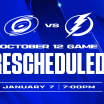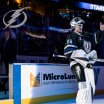In the first two rounds of the playoffs, the Lightning faced Florida and Carolina, two teams that, while not identical, both like to push the pace of play. The New York Islanders are a different type of opponent. The Islanders play a tight, structured game, meaning that their players tend to be in the right pace at the right time and make the right decisions with the puck. It can be hard to generate scoring chances against them during five-on-five play. Their sound structure not only helps the defensive side of their game, it also fuels their offensive attack. It can lead to opposition turnovers and counter chances for New York. Also, the Islanders play a physical, straightforward game, which means their ability to win puck battles on the forecheck leads to offensive zone possession time. And since their structured style also includes how they move the puck in the offensive zone, they can make life difficult on the other team to regain possession and alleviate pressure. A puck may come out to center ice, but the Islanders are in position to move it right back in.
Mishkin's Musings: How the Lightning beat the Islanders
Key to their seven-game series win, the Bolts managed to break through New York's structured style of play, as well as overcome injuries to Erik Cernak and Nikita Kucherov

© Getty Images
The Islanders reached the Semifinals by beating Pittsburgh and Boston. In both series, the Isles split the first two on the road, lost Game Three at home, then won the next three. While it wasn't surprising that the Islanders had reached the third round for the second year in a row, some of the underlying numbers through the first two rounds were uncharacteristic. While some of the contests had ended with a 2-1 final, the Islanders had been involved in a few high scoring games against the Penguins and Bruins. Their penalty kill, which had been ranked in the top-10 during the regular season, was at just 61.5% through the first two rounds. What had remained consistent about their PK, though, was the fact that the Islanders weren't shorthanded very often, either in the regular season or the playoffs.
Still, the Islanders bread and butter is team defense. And they were geared up to get another crack at the Lightning, who knocked them out of the Eastern Conference Final in the 2020 playoffs. They would be ready. As Islanders center Casey Cizikas stated before Game One: "They're going to have to beat us. We're not going to beat ourselves."
In Game One, the Islanders' solid structure and team defense was on display. The Lightning struggled to generate scoring opportunities. Semyon Varlamov was sharp in denying initial Lightning shots and the Islanders took care of any rebounds, so there were virtually no second chance opportunities for Tampa Bay. The Lightning, on the other hand, didn't manage the puck nearly as well. They committed numerous turnovers, which served to fuel New York's attack. Two of those proved to be very costly. One led to Mathew Barzal's counter rush goal in the second period and the other resulted in Ryan Pulock's slapshot tally early in the third. Brayden Point's sixth-attacker power play goal in the final minute got the Lightning on the board, but the Islanders came away with a 2-1 win.
The Lightning weren't just unhappy with their puck management in Game One, they also felt that they didn't play with enough urgency. They vastly improved those areas in Game Two. Their pace of play picked up, too, so they were able to more regularly break down New York's structure. Quick puck movement, including a no-look one-time pass from Nikita Kucherov to Point in the offensive zone, resulted in Point's opening goal at 8:58.
This game had a couple of controversial moments. The first of those occurred when Adam Pelech pushed Point into Varlamov. Point was called for a goalie interference penalty and the Islanders cashed in on the ensuing power play. But the Lightning didn't allow the blown call and goal against affect them. They kept applying pressure for the rest of the period and even though the frame concluded with the score still tied at one, they ending up recording 17 first period shots on goal.
There were fewer shots (for both teams) in the second period, but both clubs still genereated some excellent chances. Just as a New York power play ended, Andrei Vasilevskiy made a stop on Pulock with the shaft of his stick. Earlier, on same that Islanders man advantage, Varlamov stopped Yanni Gourde's shorthanded breakaway.
Ondrej Palat recorded back-to-back shots following a rush down the left wing. Varlamov made those saves, but he couldn't stop Palat's open chance from the slot at 13:15. On the play, Kucherov accepted a stretch pass from Victor Hedman and skated to the left circle in the Islanders end. He drew two New York defenders to him, which left the middle of the ice open. That's where Palat went - he accepted the pass from Kucherov and wristed a shot past Varlamov's stick.
The Lightning were changing defensemen in the neutral zone as the goal was scored. Barry Trotz complained that the Lightning had too many men on the ice. But the extra players on the ice had no bearing on the goal being scored. In the Islanders end, it was a three-on-three. The goal happened because of New York's blown coverage, not because of the Lightning having an advantage of extra players on the ice.
Jan Rutta's right point slapshot goal early in the third extended the lead and Hedman's power play tally midway through the frame made it 4-1. The Lightning killed one more penalty - which was mostly a dangerous four-on-three - to maintain the three-goal cushion. A goal from Barzal with 3:16 left made it 4-2, but the Islanders would get no closer.
Game Three was a contest in which the Lightning owned a majority of the possession time for the first 30 minutes and the Islanders had a possession edge in the final 30 minutes. But both teams defended well without the puck, so in all, this was a game that featured very few scoring chances. In the end, the Lightning made one more play than the Islanders and that proved to be the difference.
The Lightning got on the board at 10:05 when Blake Coleman followed his own initial shot and grabbed the puck behind the New York net. He centered a pass, which deflected off Nick Leddy's skate directly to Gourde at the side of the goal. Gourde buried the shot.
Up until the halfway point of the second period, the Islanders possession disadvantage meant that they weren't applying much pressure. Other than an early chance for Kyle Palmieri, the Islanders were quiet offensively. That dynamic changed at the halfway point of the second. The Islanders began winning more puck battles and, as a result, spent more time in the offensive zone. While they didn't generate many Grade-A chances, their possession advantage eventually paid off. Following a Vasilevskiy save on Matt Martin, Erik Cernak attempted to slide the puck back to Vasilevskiy. Instead, it deflected off Cal Clutterbuck and slid into the Lightning net.
The Lightning hadn't had much going since the middle of the period, but on the shift after Clutterbuck's goal, Pelech took an interference penalty and the Lightning got a chance to get the lead back before the end of the stanza. They did just that. As the penalty was expiring, Hedman took a shot from the slot that hit Andy Greene at the top of the crease. Point grabbed the rebound and swept it in.
The big response goal from Point meant that the Lightning took a lead into the third. The Lightning did well to lock things down in the final period. They ceded some possession time to the Islanders, but successfully limited shots and scoring chances against. New York posted just eight third period shots and recorded none over the final five and a half minutes of the game.
Just as the Lightning responded in Game Two following a loss, the Islanders did the same in Game Four. The Lightning did begin the game strongly, firing seven shots on net during the first five and a half minutes. Varlamov was again sharp in net, denying all of those shots (including an in-alone chance for Alex Killorn). Following those early minutes, though, the Lightning's level dropped. More turnovers crept into their game. They had less puck possession. The Islanders buzzed. Although no damage was done and the first period ended with the score 0-0, that trend continued into the second. A Lightning turnover at the offensive blue line and a coverage miscue led to Josh Bailey's opening goal at 5:30. With their raucous crowd urging them on, the Islanders surged. They won puck battles, spent lots of time in the Lightning end, and played with high urgency. They popped in two more goals - Barzal scoring on a rebound after the Islanders won a 50-50 puck in the offensive zone and Martin finished a backhander after the Lightning repeatedly failed to clear their zone.
Down 3-0, the Lightning tried to fight back in the third. Point scored off the rush, zipping a shot from the right circle past Varlamov's stick. Shortly thereafter, Tyler Johnson roofed a shot from the left circle into the top of the net. The Lightning had three other terrific chances to tie the game. But Varlamov made key saves on Ross Colton and Kucherov and then, in the closing seconds, Pulock preserved the lead with a goalline block on McDonagh's backhander from the slot.
The comeback fell short, but the Lightning liked their third period push. That carried over into the start of Game Five. The Lightning posted four shots on goal during the opening minute of the game - and the fourth of those went in. Off the rush, Steven Stamkos collected a loose puck off a Killorn shot attempt and scored into an open side of the net. The play started in the neutral zone, where Killorn closed quickly on Pelech to force a turnover. And that's what the Lightning did repeatedly in the first period of Game Five. They played a fast, hungry game and the Islanders couldn't match it. By the time the period was up, the score was 3-0 and Ilya Sorokin had replaced Varlamov in the New York net. Frankly, the score could have been even more lopsided. The Lightning generated upwards of 10 rush chances in the period.
The Islanders' best opportunity to score in Game Five came early in the second period. During one sequence in the Tampa Bay end, they put two shots on net, hit two posts, and narrowly missed the net on two other attempts. But the puck stayed out and shortly thereafter, the Lightning added to their lead with a Stamkos power play goal. The Islanders took four consecutive minor penalties in the frame. The Lightning scored on the first and fourth of those. And while they didn't tally a goal on the middle two chances, they took four more minutes off the clock. With the two power play goals and a Palat deflection tally, the Lightning led 6-0 after two. The Isles didn't have much pushback in the third, a period they played without Barzal, who was given a major penalty and game misconduct for a cross-check to the helmet of Rutta at the end of the second. Two more Lightning goals in the third set the final at 8-0. The Lightning played one of their best games in the playoffs and were rewarded for it. But as the players quickly pointed out afterwards, the lopsided victory counted as just one win, no matter the final score.
Cernak had sustained an injury in Game Four and was unavailable for Game Five or Game Six. Luke Schenn capably replaced Cernak in the lineup. But the injury count continued to rise in Game Six. Early in the first period, Kucherov took a cross-check from Scott Mayfield and played just one shift. Down to 11 forwards, the Lightning reconfigured the lines. Anthony Cirelli joined Point and Palat and the three players teamed up to score twice. Point's backhand goal from the top of the crease made it 1-0. In the second, shortly after killing off a five-on-three penalty, the Lightning added to their lead. Cirelli took a long pass from Palat and finished an in-alone chance.
Less than two minutes later, the Islanders got one of the goals back. Jordan Eberle put a backhander from the slot past Vasilevskiy's stick. That goal changed the complexion of the game. The Islanders surged, applying steady pressure through the end of the second and into the third. The Lightning spent nearly all of the first 11 minutes of the third period playing D without the puck. And when Barzal set up Mayfield at the right circle, the defenseman whistled a shot off the bottom of the crossbar and in, tying the game at 11:16.
The Lightning didn't allow the Islanders to build any momentum from the tying goal, however. They pushed back themselves. posting nine of the period's final 11 shots. Five of those came on a late power play, which was dangerous even without Kucherov. But Varlamov (again) was his team's backbone, keeping the Lightning off the board and forcing overtime. Just over a minute in, Anthony Beauvillier stole a pass in the slot and wristed the puck into the top of the net.
Game Seven was a defensive clinic for the Lightning. During most of the first two periods, they held a big possession advantage. The Islanders produced only 11 shots over the first 40 minutes - and three of those came during the only power play of the game. Of course, it was during that same power play that the only goal of Game Seven would be scored. Gourde came off the Lightning bench, accepted a pass from Cirelli in the slot, and one-timed a shot past Varlamov.
Varlamov did well to keep his team close. He made 26 saves over the first two periods. Vasilevskiy wasn't nearly as busy, but he did stop Beauviller's rush chance early in the game. In the third, the Islanders tried to make a push. That translated into more possession, but they still had a difficult time generating decent looks. The Lightning blocked 10 shots in the third, preventing those pucks from even reaching Vasilevskiy. Facing a team known for its structure and great team defense, the Lightning won the deciding game by displaying their own terrific structure and team defense.
This was, clearly, a close series and both teams had strong performances. The Islanders' solid structure was a big part of their Game One win. They used the energy of their home crowd to surge at key points in their Game Four and Six triumphs. The Lightning's ability to play fast and with high urgency helped them win Games Two and Five. Solid defensive play was crucial in Games Three and Seven.
Another reason why the Lightning won this series was their ability to overcome injuries to several players. Rutta and Cernak didn't finish Game Three. Cernak missed Games Five and Six. Kucherov only played one shift in Game Six. But in their absences, other players stepped up, either by playing more minutes when the bench was shortened, or, in the case of Schenn, entering the lineup and slotting in on the blue line.
Point and Kucherov were dazzling offensively and factored in on some of the most important goals in the series. But, as has been the case during the last two postseasons, this series victory was a team triumph. The Gourde line was outstanding. The unit of Johnson, Colton, and Maroon was also strong. After being held without a (non power play) point in the first four games, Stamkos, Cirelli, and Killorn combined for 11 points in the last three. Nine of those were either even strength or shorthanded points. The Lightning D corps was also terrific. In particular, McDonagh was a defensive rock. And if not for Pulock's heroics in Game Four, he would have scored one of the most memorable goals in franchise history.
And, of course, Vasilevskiy had himself another wonderful series. In only two of the seven games did he allow more than two goals. He posted two shutouts. But beyond his overall numbers, he provided the Lightning with timely saves at key moments throughout the series.
The Lightning won't have much time to savor this triumph. The Stanley Cup Final begins against Montreal on Monday and they'll need to be ready to face, as Stamkos stated after Game Seven, the best team the Lightning have played against so far in the playoffs.


















